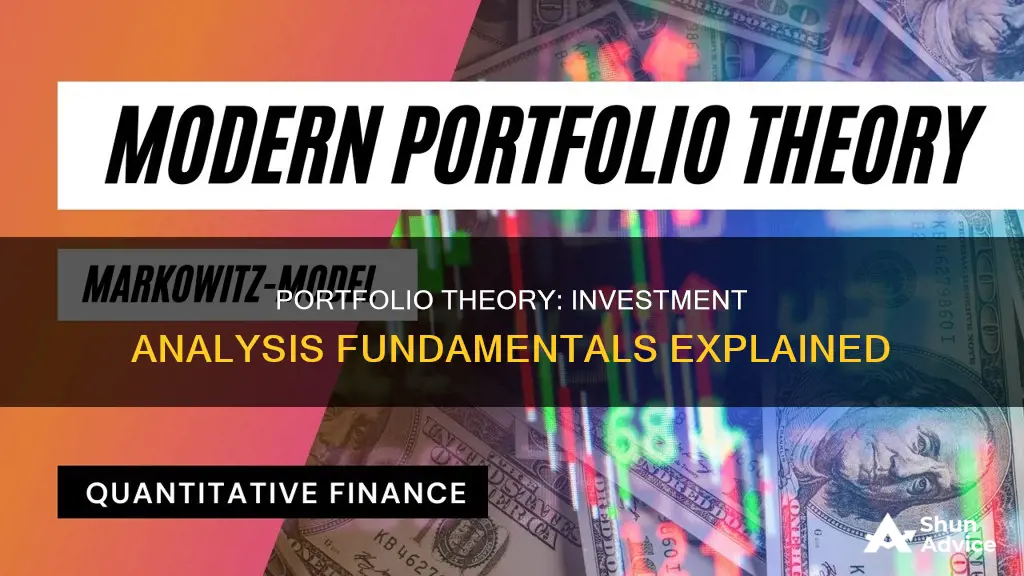
Modern Portfolio Theory and Investment Analysis is a practical method for selecting investments to maximise their overall returns within an acceptable level of risk. The theory, which was pioneered by American economist Harry Markowitz in 1952, argues that it is possible to design an ideal portfolio that will provide the investor with maximum returns by taking on the optimal amount of risk. The theory also advocates diversification of securities and asset classes.
What You'll Learn

Diversification and risk reduction
Modern Portfolio Theory (MPT) is a practical method for selecting investments to maximise their overall returns within an acceptable level of risk. It is a mathematical framework used to build a portfolio of investments that maximises the amount of expected return for the collective given level of risk.
MPT is underpinned by the concept of diversification. Most investments are either high risk and high return or low risk and low return. MPT argues that investors can achieve optimal results by choosing a mix of the two based on their individual tolerance to risk.
MPT assumes that investors are risk-averse, meaning they prefer a less risky portfolio to a riskier one for a given level of return. This implies that most people should invest in multiple asset classes.
The expected return of a portfolio is calculated as a weighted sum of the returns of the individual assets. For example, a portfolio with four equally weighted assets with expected returns of 4%, 6%, 10%, and 14% would have an expected return of 8.5%.
The risk of a portfolio is a function of the variances of each asset and the correlations of each pair of assets. To calculate the risk of a four-asset portfolio, an investor needs each of the four assets' variances and six correlation values, as there are six possible two-asset combinations. Due to the asset correlations, the total portfolio risk, or standard deviation, is lower than what would be calculated by a weighted sum.
MPT is a useful tool for investors constructing diversified portfolios. For example, stock investors can reduce risk by allocating a portion of their portfolios to government bond ETFs. The variance of the portfolio will be significantly lower because government bonds have a negative correlation with stocks.
MPT also allows investors to construct more efficient portfolios. Every possible combination of assets can be plotted on a graph, with the portfolio's risk on the x-axis and the expected return on the y-axis. This plot reveals the most desirable combinations for a portfolio.
For instance, suppose Portfolio A has an expected return of 8.5% and a standard deviation of 8%, while Portfolio B has an expected return of 8.5% and a standard deviation of 9.5%. Portfolio A would be deemed more efficient because it has the same expected return but lower risk.
MPT suggests that it is not enough to consider the expected risk and return of one particular stock. By investing in multiple stocks, investors can benefit from diversification, primarily a reduction in the riskiness of the portfolio.
MPT quantifies the benefits of diversification. It states that the risk in a portfolio of diverse individual stocks will be less than the risk inherent in holding any one of the individual stocks, provided the risks of the various stocks are not directly related.
For instance, consider a portfolio that holds two risky stocks: one that pays off when it rains and another that pays off when it doesn't rain. A portfolio that contains both assets will always pay off, regardless of the weather. Adding one risky asset to another can reduce the overall risk of an all-weather portfolio.
MPT states that the risk for individual stock returns has two components: systematic risk and unsystematic risk. Systematic risk refers to market risks that cannot be diversified away, such as interest rates, recessions, and wars. Unsystematic risk, also known as specific risk, is specific to individual stocks, such as management changes or a decline in operations. This type of risk can be diversified away by increasing the number of stocks in the portfolio.
In a well-diversified portfolio, the risk of each stock contributes little to the overall portfolio risk. Instead, it is the difference between each stock's level of risk that determines the overall portfolio risk. As a result, investors benefit from holding diversified portfolios instead of individual stocks.
Understanding the Efficient Frontier: Maximizing Investment Portfolio Returns
You may want to see also

The economic intuition behind portfolio theory
Modern Portfolio Theory (MPT) is a practical method for selecting investments to maximise their overall returns within an acceptable level of risk. It is underpinned by the idea that it is possible to design an ideal portfolio that will provide the investor with maximum returns by taking on the optimal amount of risk.
MPT is based on the idea that investors can reduce risk through diversification using a quantitative method. It is not enough to look at the expected risk and return of one particular stock. By investing in more than one stock, an investor can reap the benefits of diversification, chiefly among them, a reduction in the riskiness of the portfolio.
MPT quantifies the benefits of diversification, or not putting all your eggs in one basket. It argues that stocks face both systematic risk (market risks such as interest rates and recessions) and unsystematic risk (issues specific to each stock, such as management changes or poor sales). Proper diversification of a portfolio cannot prevent systematic risk, but it can dampen, if not eliminate, unsystematic risk.
MPT assumes that investors are risk-averse, meaning they prefer a less risky portfolio to a riskier one for a given level of return. It also assumes that the risk investors take when they buy a stock is that the return will be lower than expected. In other words, it is the deviation from the average return. Each stock has its own standard deviation from the mean, which MPT calls "risk".
The risk in a portfolio of diverse individual stocks will be less than the risk inherent in holding any one of the individual stocks, provided the risks of the various stocks are not directly related. For example, consider a portfolio that holds two risky stocks: one that pays off when it rains and another that pays off when it doesn't rain. A portfolio that contains both assets will always pay off, regardless of the weather. Adding one risky asset to another can reduce the overall risk of an all-weather portfolio.
MPT states that the risk for individual stock returns has two components:
- Systematic Risk: Market risks that cannot be diversified away, such as interest rates, recessions, and wars.
- Unsystematic Risk: Also known as "specific risk", this is specific to individual stocks, such as a change in management or a decline in operations. This kind of risk can be diversified away as you increase the number of stocks in your portfolio.
For a well-diversified portfolio, the risk of each stock contributes little to portfolio risk. Instead, it is the difference between each stock's level of risk that determines overall portfolio risk. As a result, investors benefit from holding diversified portfolios instead of individual stocks.
The efficient frontier is a cornerstone of MPT. It is the line that indicates the combination of investments that will provide the highest level of return for the lowest level of risk. For every level of return, there is one portfolio that offers the lowest possible risk, and for every level of risk, there is a portfolio that offers the highest return. These combinations can be plotted on a graph, and the resulting line is the efficient frontier.
Any portfolio that lies on the upper part of the curve is efficient: it gives the maximum expected return for a given level of risk. A rational investor will only ever hold a portfolio that lies somewhere on the efficient frontier. The maximum level of risk that the investor will take on determines the position of the portfolio on the line.
MPT suggests that combining a stock portfolio that sits on the efficient frontier with a risk-free asset, funded by borrowing, can increase returns beyond the efficient frontier. In other words, if you borrow to acquire a risk-free stock, then the remaining stock portfolio could have a riskier profile and, therefore, a higher return than you might otherwise choose.
MPT has had a marked impact on how investors perceive risk, return, and portfolio management. The theory demonstrates that portfolio diversification can reduce investment risk. However, it also has some shortcomings. For example, it often requires investors to rethink notions of risk and take on a perceived risky investment to reduce overall risk. Furthermore, it assumes that it is possible to select stocks whose individual performance is independent of other investments in the portfolio, which is not always the case.
Savings and Investment: Autonomy and its Economic Impact
You may want to see also

Modern portfolio theory's strengths and weaknesses
Modern Portfolio Theory's Strengths:
Modern Portfolio Theory (MPT), introduced by Harry Markowitz in 1952, is a powerful tool for investors, offering several benefits:
- Risk and Return Optimisation: MPT enables investors to optimise the risk-return trade-off. By diversifying investments, it helps achieve the highest possible return for a given level of risk.
- Diversification: MPT promotes diversification, encouraging investors to spread investments across various assets that are not perfectly correlated. This strategy helps mitigate risk and can be advantageous during market volatility.
- Quantifiable Measures: MPT provides a mathematical approach to portfolio management, employing quantifiable measures of risk, such as variance and standard deviation. This allows investors to make informed decisions and effectively plan and forecast.
- Improved Decision-Making: Investors can make more informed decisions by utilising measures like the Expected Return on a portfolio.
Modern Portfolio Theory's Weaknesses:
Despite its strengths, MPT has several limitations and has faced criticism:
- Based on Historical Data: MPT relies heavily on historical data, assuming past asset performance accurately predicts future performance. This assumption may not hold true in the unpredictable financial markets.
- Oversimplification of Risk: The theory simplifies risk by associating it mainly with volatility, potentially neglecting other critical risk types, such as liquidity, credit, and operational risks.
- Unrealistic Assumptions: MPT assumes investors are rational and risk-averse, which may not reflect real-world investor behaviour influenced by behavioural biases.
- Underestimation of Systemic Risks: MPT may underestimate the impact of systemic risks or "black swan" events that affect all asset classes. Diversification may not mitigate these risks.
- Correlation Limitations: The theory assumes asset correlation stability over time, but this may not hold during market volatility, as correlation trends can change dramatically.
ETFs: Smart Short-Term Investment Strategy for Savings?
You may want to see also

Quantitative methods for portfolio analysis
Quantitative trading analysts, or "quants", employ various data sources, including historical investment and stock market data, to develop trading algorithms and computer models. These models assist investors in making profitable investment decisions by providing quantifiable statistics and metrics.
The ultimate goal of quantitative analysis in finance is to aid investors in making profitable investment decisions by identifying trading patterns, building models to assess those patterns, and making predictions about the price and direction of securities.
One of the key texts in this field is "Quantitative Methods for Portfolio Analysis: MTV Model Approach" by T. Kariya. This book provides practical models and methods for the quantitative analysis of financial asset prices, the construction of portfolios, and computer-assisted trading systems. It is aimed at 'quants' in financial industries, financial engineers, graduate students, and investors interested in Japanese financial markets.
Another important aspect of quantitative methods in portfolio analysis is the use of statistical performance reviews, risk and risk-adjusted metrics, attribution, and positioning. This process involves analysing the performance of a portfolio over a specific period, evaluating the level of risk assumed, and attributing returns.
Additionally, portfolio analysis can be applied to mutual funds, closed-end mutual funds, and exchange-traded funds (ETFs). It can also be used to evaluate security analysis and portfolio management practices.
In conclusion, quantitative methods for portfolio analysis provide valuable insights and tools for investors and analysts to make informed decisions, optimise portfolios, and improve investment performance.
Monitoring Your Investment Portfolio: Strategies for Success
You may want to see also

The efficient frontier
A key finding of the concept was the benefit of diversification resulting from the curvature of the efficient frontier. The curvature is integral in revealing how diversification improves the portfolio's risk/reward profile. It also reveals that there is a diminishing marginal return to risk. Adding more risk to a portfolio does not gain an equal amount of return—optimal portfolios that comprise the efficient frontier tend to have a higher degree of diversification than the sub-optimal ones, which are typically less diversified.
Savings Transform to Investment: When and How?
You may want to see also
Frequently asked questions
Modern Portfolio Theory and Investment Analysis is a book by Edwin J. Elton, Martin J. Gruber, Stephen J. Brown, and William N. Goetzmann. It examines the characteristics and analysis of individual securities, as well as the theory and practice of optimally combining securities into portfolios.
The book covers a range of topics, including the economic intuition behind investment analysis, advanced concepts of portfolio management, the benefits of diversification, and the latest breakthroughs in the field.
The book is intended for investors who want to maximise their returns within an acceptable level of risk. It provides a practical method for selecting investments and constructing efficient and diversified portfolios.
Modern Portfolio Theory argues that any given investment's risk and return characteristics should be evaluated in the context of the overall portfolio, rather than in isolation. It suggests that investors can achieve greater returns without taking on more risk by constructing a portfolio of multiple assets.
The Efficient Frontier is a cornerstone of Modern Portfolio Theory. It is a plot of all the most efficient portfolios, with the portfolio's risk on the x-axis and the expected return on the y-axis. Portfolios above the Efficient Frontier are considered desirable as they maximise returns for a given level of risk.







